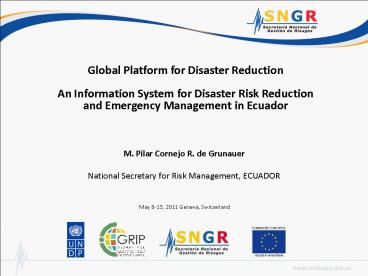Diapositiva 1 - PowerPoint PPT Presentation
Title:
Diapositiva 1
Description:
Global Platform for Disaster Reduction An Information System for Disaster Risk Reduction and Emergency Management in Ecuador M. Pilar Cornejo R. de Grunauer – PowerPoint PPT presentation
Number of Views:43
Avg rating:3.0/5.0
Title: Diapositiva 1
1
Global Platform for Disaster Reduction An
Information System for Disaster Risk
Reduction and Emergency Management in Ecuador
M. Pilar Cornejo R. de Grunauer National
Secretary for Risk Management, ECUADOR May
8-13, 2011 Geneva, Switzerland
2
- Ecuador shares with other countries in the Andean
Region its acute vulnerability and high risk
exposure to several natural hazards (i.a.
earthquakes, volcanic eruptions, floods, gales,
landslides, droughts, tsunamis), and other
manmade disasters. - The National Government has decided to firmly
support disaster risk management as an
opportunity for domestic change and capacity
building
3
- The National Government seeks to establish
disaster risk management as a State policy by,
among other measures, promoting disaster risk
management mainstreaming in all private and
public institutions planning and management
processes fostering a preparedness culture at all
levels within society and the State.
4
- The 2008 Constitution (Sep. 2008) includes risk
management explicitly. - The national security law (Sep. 2009)
established the National Secretary of Risk
Management as the rector of the system. - The development of the National Decentralised
Risk Management System is also mandatory.
5
- Art. 389 reads that the State shall protect all
individuals, communities and Nature from the
adverse effects of natural or manmade disasters
through risk preparedness and prevention
activities, disaster mitigation and
rehabilitation actions, as well as measures aimed
at improving social, economic and environmental
conditions in order to minimize their
vulnerability.
6
- Art. 389 continued...
- The National Decentralised Risk Management
System is composed of the risk management units
of all private and public institutions at local,
regional and national level. - SNGR was later designated the lead agency to act
on behalf of the State, and given a Ministry
status.
7
- Art. 390 states that risks shall be managed
according to the principle of decentralized
subsidiary action. This shall entail the direct
responsibility of institutions within their
respective geographical area of influence. If
their risk management capacities are surpassed,
the higher institutional level shall be activated
and agencies with larger territorial jurisdiction
and technical and financial capacity shall
provide the necessary support with due respect
for their authority and without taking over their
responsibility.
8
- Access to Information is a key element for sound
decision making for risk reduction and
management. - SNGR promotes free access to reliable and
verified information by closely working with the
technical and scientific organizations which are
the first providers of information and addressing
the specific needs of different actors.
Mayo de 2011
9
- The national information system for risk
management has been set up as a tool to assist
end users in the search of appropriate
information for different purposes, being the
most relevant the following - Emergency Management
- Logistics
- Volunteering Organizations Including Civil
Protection - Resources
- Library
- Capacity Building and Training
- Telecommunications
- Technical information related to hazards,
vulnerabilities, capacities
10
Web Based Information System
Mayo de 2011
11
SUBSISTEMA DE GESTIÓN DE RIESGOS
Mayo de 2011
12
The data system has incorporated visual aids to
make it easier and more attractive. It includes
geo referenced maps, stastistics and allows the
user easy to manage analisis of the information
and reports.
Mayo de 2011
13
SUBSISTEMA DE GEOINFORMACIÓN
Módulo de Mapas Mapas en diferentes vistas y los
generados y cargados por el personal de la
institución.
Mayo de 2011
14
SUBSISTEMA DE GEOINFORMACIÓN
Módulo de Monitoreo Visualiza los eventos
suscitados nacional e internacionalmente y el
monitoreo actual de los mismos.
Mayo de 2011
15
SUBSISTEMA DE GEOINFORMACIÓN
Módulo de Emergencias Visualiza los eventos que
se han registrado y los georeferencia en el mapa.
Tiene acceso libre y restrictivo para la
información sin confirmación.
Mayo de 2011
16
SUBSISTEMA DE GEOINFORMACIÓN
Módulo de Capacidades Visualiza y permite
efectuar consultas interactivas de información y
generar reportes personalizados por el usuario.
Mayo de 2011
17
As part of this effort, in alliance with
different international cooperation agencies,
such as ECHO through its VI DIPECHO Action Plan,
UNDP Ecuador, and the GRIP Programme, the
National Secretariat for Risk Management is
currently leading the definition of a
standardized and tested methodology to estimate
vulnerabilities at the municipal level in Ecuador.
Mayo de 2011
18
Four natural hazards are considered in this first
stage earthquakes, volcanic activity, floods and
landslides. Major challenge relates to the
availability of information at the municipal
level that allows the use of state of the art
concepts while making it useful and practical for
local governments. Also vulnerabilities
evaluated go beyond the traditional physical ones
and take into account social and economic,
organizational, institutional and legal
vulnerabilities.
Mayo de 2011
19
As part of the analysis, physical vulnerability
of lifelines such as the water and sewerage
systems are considered in an effort to take into
account one of the most vulnerable elements in
Ecuador and its importance to risk reduction and
emergency management.
Mayo de 2011
20
- This methodology is being worked out with the
National Planning Office (SENPLADES) which will
use it as a complementary tool to mainstream DRR
into the Development and Planning Instruments
that Local Governments are required to put
together. - This remains a challenge for the upcomming months!
Mayo de 2011































